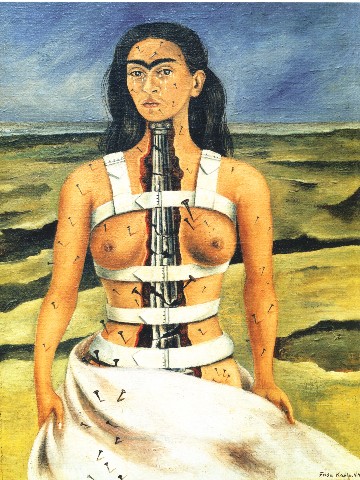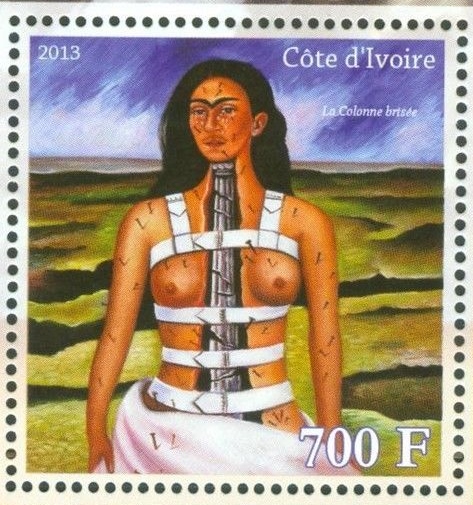The Broken Column
1944
This self-portrait is in sharp contrast to Frida's other self-portraits in that she is all alone… no monkeys, no cats, no parrots, and no background of protective leaves and plants. Instead, Frida stands all alone crying on a vast baron plain beneath a stormy sky. Perhaps it's her way of expressing that she must deal with her physical and emotional pain on her own.
In 1944 when Frida painted this self-portrait, her health had deteriorated to the point where she had to wear a steel corset for five months. She described the experience as a "punishment". The straps of the corset seem to be all that is holding the artist's broken body together and upright. An Ionic column, broken in several places, symbolizes her damaged spine. The yawning cleft in her body is repeated in the furrows of the bleak fissured landscape. An even more powerful symbol of her pain are the nails piercing her face and body. The nails represent the physical pain she has endured since her accident. The larger nail piercing her heart represents the emotional pain caused by Diego.
When Frida's long time friend and art student, Arturo Garcia Bustos, saw the finished painting he was terribly distressed by the message it conveyed. Although the painting is obviously a reflection of her current physical and emotional state at the time, it also carries a message of humor in it. "You must laugh at life…" Frida said. "Look very very closely at my eyes…the pupils are doves of peace. That is my little joke on pain and suffering…"
The haunting image in this painting and the entries in her diary are a testament to the physical and emotional pain that Frida suffered during the last ten years of he life.
Originally Frida painted herself completely nude but then later decided that her total nudity distracted from the central theme and focus of the painting.
In 2013, an image of this painting was featured on a postage stamp from the African nation of the Ivory Coast.

(Click Here to View Larger Image)
(Pinche aquí para ver la imagen aumentada)
Oil
on canvas
mounted on masonite
17" x 13"
Collection of Dolores Olmedo Patiño
Mexico City, Mexico
Óleo sobre lienzo
montado sobre fibra dura
43 x 33 cm.
Colección
de Dolores Olmedo Patiño
Ciudad de México, México

2013
Ivory Coast Stamp
2013 sello
de Costa de Marfil
La columna rota
1944
Este autorretrato es un gran contraste con otros autorretratos de Frida ya que ella se pintó sola… no monos, no gatos, no pericos y no fondo de hojas protectoras y plantas. En lugar de eso, Frida está sola, llorando en una vasta llanura bajo un cielo tormentoso. Quizás es su manera de expresar que tiene que manejar su dolor físico y emocional por sí misma.
En 1944, cuando Frida pintó este autorretrato, su salud se había deteriorado hasta el punto de tener que llevar un corsé de acero para sujetar su columna vertebral durante cinco meses. Describió la experiencia como un "castigo". Las correas del corsé parecen ser lo único que aguanta el cuerpo roto de la artista en una pieza y erecto. Una columna jónica, rota en varias partes, representa su columna dañada. La dramática abertura en su cuerpo y las fisuras del seco paisaje se convierten en símbolos del dolor y la soledad de la artista. Este sentimiento se ve acentuado por el poderoso símbolo de los clavos atravesando su cara y cuerpo. El clavo más largo agujereando su corazón indica la fuente de el dolor emocional causado por Diego.
Cuando Arturo Garcia Bustos, un estudiante de arte y amigo de mucho tiempo de Frida, vio el cuadro acabado, estaba terriblemente angustiado por el mensaje que ofrecía. Aunque el cuadro es obviamente un reflejo de su estado emocional y físico en ese momento, tambien lleva un mensaje humorístico. "Tienes que reirte de la vida..." Frida dijo. "Mira los ojos muy de cerca... las pupilas son palomas de la paz. Esta es mi bromita sobre el dolor y el sufrimiento...".
La imagenes que frecuenta en esta pintura y las entradas en su diario son un testamento al dolor físico y emocional que Frida sufrió durante los diez años pasados de su vida.
Originalmente Frida se pintó completamente desnuda pero más tarde decidió que el desnudo integral distraía del tema central y foco del cuadro.
En 2013, una imagen
de esta pintura se presentó en un sello de la nación africana
de la Costa de Marfil.